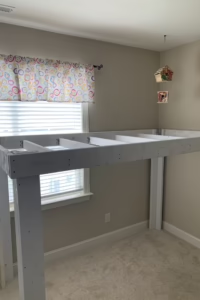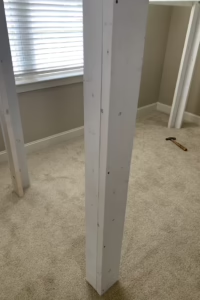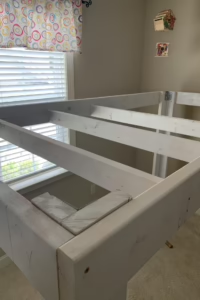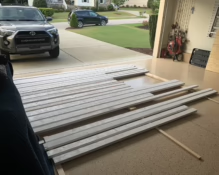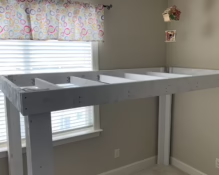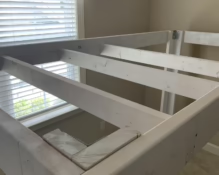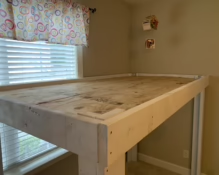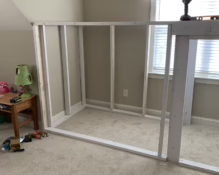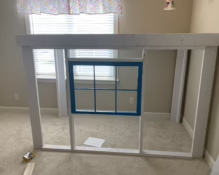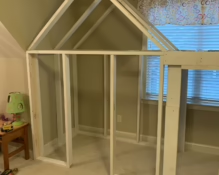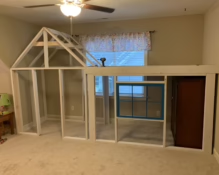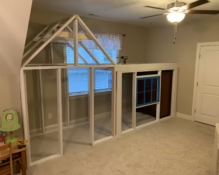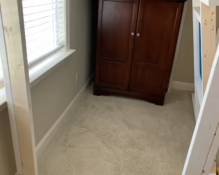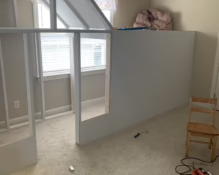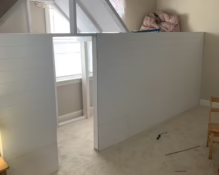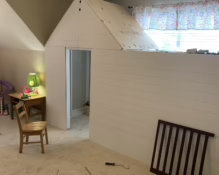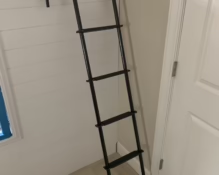
When my daughter asked for a playhouse, the thought of something plastic in the yard that would likely only get used in good weather and would be exposed to the elements all the time didn’t really thrill me. So, we decided to take the project inside and create a space that could be used year round, and as a bonus, could hide lots of toys that are usually just thrown around. So, our bravery (ignorance?) led us to build a playhouse.
We’re lucky enough to have an extra room in our home that our daughter has adopted as her playroom. Naturally, that was the place for the playhouse. We took a wall that had natural light and about a four foot by fifteen foot offset from the rest of the room, and decided to build there. I wanted to fill the space, but make the house freestanding so we could remove it later with as little damage as possible.
My wife and I looked all over the internet for designs / inspiration or even actual plans for something like this, and nothing quite fit what we were looking for. So, I decided to design our own. I drew a few sketches and let the family decide what features and looks they liked. Then when that was decided, I drew up scale drawings for us to build off of and plan our materials purchases. It gave me a chance to dust off the old high school drafting supplies and have at least a rough roadmap to build from.
I created roughly scale views of each side and the top, then estimated my materials from those sketches. I didn’t have a true plan for the door, the ladder, or railing yet, so we started with just the structure itself. We brought all of that out and did a quick first coat of white on everything. Since this was going to be on carpet in the playroom, we were hoping to paint as much as possible outside before the assembly inside.
I ended up with a whole extra sheet of plywood due to a design change midway through that we made, and only had to purchase one additional 2×4 at the end from the original lumber order. In my book, that’s a success.
After we had a painting party to put a base white coat on all the lumber, I started cutting and assembling. The design is basically a twin bed-sized loft with an attached mini house. So the first place to start was the loft portion of the design. We used a 2×6 + 2×4 for each leg instead of 4×4 posts which are harder to find untreated. You can’t paint new pressure treated lumber easily, so don’t waste your time there.
After I built the 4 legs, I assembled a rectangle frame from 2x6s that was 8 feet long and about 3.5 feet wide. I added the legs to each corner, upside down, squaring them up as I screwed each one in. After all the legs were attached, I flipped it onto its legs and began the cross beams.
For the cross beams, I used standard 2x4s about 16 inches on center, screwed through the outside frame with two screws on each end, and reinforced with a joist hanger bracket on each end as well.
Framing the Window and the Main Wall

To finish out the loft part, I framed in the reclaimed flea-market window that we bought for this project. The
far right stud is 24 inches on center from the far right leg, then the other stud goes where the window ends on the other side. I built this “wall” on the floor, then raised it and attached it to the frame of the loft once complete.
At this time I also moved our daughter’s dress-up armoire under the loft. This was a key feature for us to hide this closet where all the princess dresses and tiaras live, so we made sure that the width of the loft would accommodate the width of this piece of furniture.
Next, I needed to map out and build the walls for the rest of the “house.” Since this thing isn’t attached and part of the home for perpetuity, nor is it truly structural, I took some liberties with the stud gaps here. I went 24 inches on center instead of the normal 16, to save cost where it wouldn’t affect the look or function of the playhouse.
I started from the loft in the back and worked my way over to the other wall, centering a doorway in the front wall, and just creating a regular wall for the back and side. The loft-side wouldn’t have a wall, but rather the back and front of the house walls would connect directly to the legs of the loft, serving as a support that can be walked through/under. The 2×6 on the short side of the loft basically acts as a header would in a normal doorway you’d see in standard construction.
After all the walls were built, I began constructing the roof section. I used a 2×4 for the ridge beam, and angle cut six 2x4s to make 3 truss-style ribs, then set the whole structure on top of the entry section of the house. Then I used plywood for the roof sheathing.
Finishing Touches
At this point, the structure of the playhouse has been built, and everything else from this point forward is finishing and decorative. The siding, is a simple paneling that you can get at your local hardware store pre-primed in white. Since the total height of the structure is higher than the width of a panel, I started at the top right so any seams/gaps would be toward the bottom and not at eye level.
First, I removed the window, then tacked the panel up with a few brads and traced the window opening, then cut it out and re-hung it, but this time, I used liquid nails adhesive to glue the panels to the studs and a few brads at the top to hold it while the adhesive dried.
Rather than measuring, cutting and hoping on the roof angles, I tacked rectangles to the truss structure, and traced what needed to be cut. After cutting into triangles, I tacked and glued these just like the other panels.
After all the paneling was up, the next step was to finish the door, window, and the roofline. I used standard pre-primed molding miter cut to frame in the door and windows. I took the same molding and outlined the roofline to give it the look of an eave.
To give this playhouse some authenticity, we went with real shingles here. I bought one pack of shingles, and it was just enough to cover the 32 sq. foot roof. Rather than nailing this down like you would in an actual installation, I used wood staples to prevent nails poking through the thin roof that someone could get hurt on. At the top where the ridge vent would be in a normal roof, I simply used some scrap shingle pieces to form a cap there. I started on the right side since this is most visible, and finished on the back left corner, where no one will ever really see.
The loft platform is going to be used as a reading / TV watching space for our daughter, so we wanted it to be comfortable. We used a carpet remnant and standard carpet padding on the loft. You could probably forgo the padding here if you wanted.
The ladder is an RV ladder designed to hang in the brackets and be removable if needed. This was the perfect solution for us, as we may want to prevent anyone from being on the loft when not supervised. It is lightweight and matched our color scheme well.
We used lightweight black piping for the rail system. This is a pipe system that you can find at your local hardware store or online, and is specially targeted for design elements versus being used as a real pipe. Since the frame of the loft is at the top of the “house,” it is a perfect spot to mount the two pipe supports on each side. This creates a sturdy barrier for our purposes. However, your situation and child might be different.
The mailbox is a hobby mailbox with a shelf bracket as a support. Our daughter loves “getting mail” in her very own mailbox.
Finally, we found some peel and stick pink wallpaper for the back side of the paneling to cover up the brown pressboard color.
All in all, this took about 2 weekends of almost full work, but our daughter absolutely loves having her own house and private escape to read her books or watch television.
Below is the full gallery. If you’ve got any questions, just leave a comment below and I’ll do my best to answer. Thanks!



